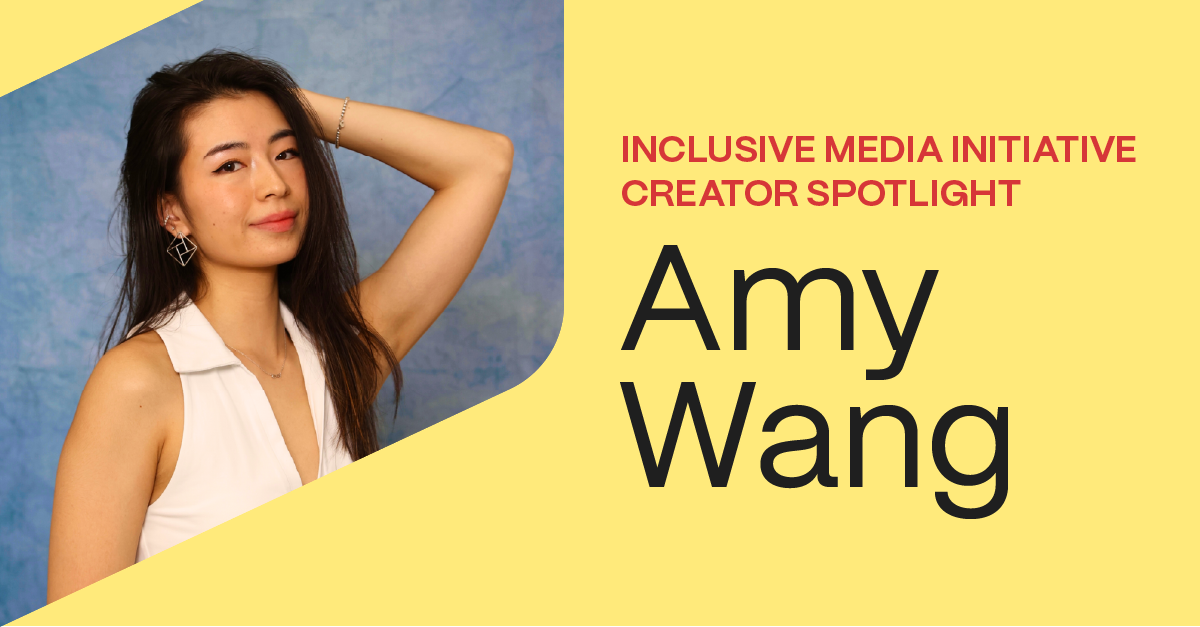
Inclusive Media Initiative Creator Q&A: Amy Wang
Pixability’s Inclusive Media Initiative amplifies the voices of diverse creators, fostering representation and connection across digital media. By showcasing YouTube creators from varied backgrounds and identities, we aim to challenge stereotypes and celebrate inclusivity.
The Lunar New Year is a time for family, reflection, and celebration, deeply rooted in traditions that honor the past while looking forward to new beginnings. For many Asian creators, this holiday represents not only a cultural milestone but also an opportunity to share their heritage with a global audience. As part of Pixability’s Inclusive Media Initiative, we’re spotlighting creators who use their platforms to celebrate diversity and amplify underrepresented voices.
In this post, we’re thrilled to feature Amy Wang, a dynamic creator who seamlessly weaves elements of her Asian heritage into her content. From inspiring her followers with stories of resilience and family values to offering unique insights into health and harmony, Amy demonstrates how cultural identity can be a source of strength and creativity. Join us as we learn how her background shapes her work, her Lunar New Year traditions, and her passion for bridging cultural connections through her zodiac-themed YouTube store.
Theresa: Can you tell us a little about your background and how your Asian heritage influences your work as a content creator?
Amy: I grew up in Colorado. My parents were both immigrants from China and my sister and I were born in the US. My sister and I both attended Caltech (California Institute of Technology) for undergrad and we now both live in NYC. I worked as a business management consultant before switching to full-time creatorpreneur.
There are so many values that were ingrained by my parents from a young age and especially affected how I approach school and living our best lives (which is what my content centers around), so it really influences the advice I give to students and my perspective on life through and through, without me even actively trying.
I do believe that my heritage also makes me gravitate toward other Asian American creators since they generally also understand common struggles, how our parents may not understand us creating content seriously.
Theresa: Are there specific cultural values or traditions from your background that you try to integrate into your content?
Amy: Family values: From my understanding and experience, as well as what my parents taught us, in many Asian cultures, family is seen as the foundation of one’s identity and responsibilities. While family is important across all cultures, there’s often a unique emphasis in Asian traditions on placing the family’s well-being above individual desires. This mindset isn’t about self-sacrifice for the sake of others, but about recognizing that our successes and actions are deeply interconnected with the collective happiness and progress of the family. In my videos, I often encourage people to ‘do it for your family’ because that reflects the values I grew up with. It’s not just about achieving personal goals, but about creating opportunities, security, and pride for the people who have supported us. This perspective is incredibly motivating and fosters a sense of purpose that’s bigger than ourselves.
This video performed really well and had very positive feedback on both my podcast channel and main channel and all it was about was my grandparents story of starting from poverty, raising my dad and helping him with his education despite struggles, and eventually allowing my sister and I to grow up in the US.
Health values: My mom and dad always say that without health, nothing else matters. My mom taught me about Traditional Chinese medicine and simple healthy habits like drinking water first thing in the morning, drinking warm water, drinking tea, eating pig trotters, eating ginger, consuming herbs, keeping harmony in the body. I demonstrate this value by always advising to put health first to excel without burn out.
Related to harmony, I emphasize in my content that discipline and success shouldn’t be forced, but rather yin yang is like mindset and action where your mindset can influence your action and vice-versa. Thus, it’s important to let the two live in harmony to propagate each other positively.
For me, succeeding in school sustainably came down to sticking to traits such as work ethic, resilience, determination.
Growing up in a predominantly white neighborhood, I wasn’t always confident enough to showcase parts of my Chinese culture, but now in videos, sometimes I share Chinese proverbs, I wear a shirt with a Mandarin color, I wear DAWANG (my friend is the founder of this brand), I talk about unique foods I eat like pig ears, and I will share what it’s like going back to China to visit my grandparents.
And overall, I’m proud of representing a Chinese American, who though ironically my channel might seem like it’s about good grades, I’m actually emphasizing the personable and soft skills I used to excel academically and outside of school. I think that by talking about school, I’m actually breaking the stereotype that Asian Americans are bookworms/nerds since I simply want to reach my potential, use my time wisely, and try many different activities. I show that each person is multifaceted, since I also played varsity tennis and basketball and I love singing and being social. I show that our background and heritage doesn’t define us, since people can directly see all the effort, habits, and mindsets I used to get good grades due to my transparency with my journey. Thus, they can understand that it’s not “just because I’m Asian” as the stereotype.
In a few videos, I’ve shared about the Chinese zodiacs.
Theresa: How do you navigate representing your heritage while appealing to a broader audience?
Amy: I focus on authentically sharing my experiences while highlighting themes that resonate universally. Representing my heritage means being proud of where I come from, but I frame those stories in a way that invites others to relate, whether through shared values, challenges, or aspirations. It’s about celebrating diversity while building bridges through common ground. This video I shared above is a great example.
Also, making my Chinese heritage a reason behind certain habits or an integrated part of my video versus the whole video is a great way to appeal to more people too. The whole video’s topic is more universally appealing so different people will click and watch.
Theresa: Do you share Lunar New Year-related content with your audience? If so, what kind of response have you received?
Amy: Yes, each year I share some Reels about Lunar New Year and integrate it into my long-form content to promote my zodiac merch.
On a related note, I shared a photo of my red Chinese wedding dress (qipao style) recently and so many people loved it over the Western white dress options. They said how they like that it reflects my culture. (I will be wearing both red and white dresses).
Theresa: Can you tell us about your zodiac themed YouTube store? How did you come up with the ideas for the merch and how has it been working out for you?
Amy: The store is here. During my zodiac year, the Year of the Tiger, I really wanted a red shirt with gold that I could wear to showcase my zodiac and culture proudly. I didn’t find any existing clothing that fit what I wanted so I reached out to my talented doubles tennis partner and friend from high school to design it with me. Each year we make a watercolor and a gold design where the zodiac animal accompanies the Chinese character.
The zodiac merch is primarily a passion project; I don’t really push the merch a lot nor expect a lot of sales. We don’t earn that much money from it but I’m grateful for my friend @bytenleybrady who also is genuinely excited about the mission behind it so it’s become a tradition for us to design annually and stay in touch that way.
Theresa: What advice would you give to other AAPI creators looking to amplify their voices and celebrate their heritage through content?
Amy: I think it first comes from genuine appreciation and pride in your culture, which allows you to passionately and naturally showcase its elements. Your heritage might already influence your daily life in ways like the dishes you eat, the clothes you wear, or the decorations in your home. By being authentically yourself, you’ll find personal happiness first, without worrying too much about public reception. It’s essential to like your content and care about your opinion more than anyone else’s, so having a solid foundation for why you’re creating—intrinsic motivation and internal confidence—is key.
I recommend sharing real stories: your family history, how it shaped your life, reasons behind lifestyle choices, the history of certain foods, and the myths or traditions that inspire you. Storytelling makes your heritage relatable and meaningful to others.
Regarding amplifying voices in general, one challenge for me in starting content creation was that we weren’t taught—it’s not typically an Asian value—to be outspoken, put ourselves out there, or be outgoing. My sister and I had to adapt to give ourselves opportunities by stepping outside our comfort zones. There’s no easy way to become louder except to start being uncomfortable—eventually, it will feel natural. If what you’re sharing isn’t common, embrace that uniqueness. Social media thrives on fresh perspectives, and your authenticity can be your greatest strength.
Theresa: How can brands, media companies, and platforms better support AAPI creators and communities?
Amy: I think it’s important that they not only use the visual elements, but that they also present a true understanding of the culture and stories rather than just use it as a marketing gimmick. It’s important that AAPI creators and communities are represented authentically and true to ourselves so I hope that brands, media companies, and platforms show a genuine interest in learning and understanding, in addition to the marketing activities like using more cultural elements in styling or working with more AAPI creators.
To learn more about Pixability’s Inclusive Media Initiative, or to sign up, see below.
